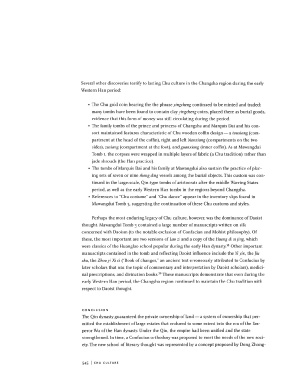Page 546 - The Golden Age of Chinese Archaeology: Celebrated Discoveries from the People’s Republic of China
P. 546
Several other discoveries testify to lasting Chu culture in the Changsha region during the early
Western Han period:
• The Chu gold coin bearing the the phrase yingcheng continued to be minted and traded;
many tombs have been found to contain clay yingcheng coins, placed there as burial goods,
evidence that this form of money was still circulating during the period.
• The family tombs of the prince and princess of Changsha and Marquis Dai and his con-
sort maintained features characteristic of Chu wooden coffin design — a touxiang (com-
partment at the head of the coffin), right and left bianxiang (compartments on the two
sides), zuxiang (compartment at the foot), and guanxiang (inner coffin). As at Mawangdui
Tomb i, the corpses were wrapped in multiple layers of fabric (a Chu tradition) rather than
jade shrouds (the Han practice).
• The tombs of Marquis Dai and his family at Mawangdui also sustain the practice of plac-
ing sets of seven or nine sheng ding vessels among the burial objects. This custom was con-
tinued in the large-scale, Qin-type tombs of aristocrats after the middle Warring States
period, as well as the early Western Han tombs in the regions beyond Changsha.
• References to "Chu costume" and "Chu dance" appear in the inventory slips found in
Mawangdui Tomb 3, suggesting the continuation of these Chu customs and styles.
Perhaps the most enduring legacy of Chu culture, however, was the dominance of Daoist
thought. Mawangdui Tomb 3 contained a large number of manuscripts written on silk
concerned with Daoism (to the notable exclusion of Confucian and Mohist philosophy). Of
these, the most important are two versions of Lao zi and a copy of the Huang di si jing, which
38
were classics of the Huanglao school popular during the early Han dynasty. Other important
manuscripts contained in the tomb and reflecting Daoist influence include the Yiyin, the Jiu
zhu, the Zhouyi Xi ci ("Book of changes," an ancient text erroneously attributed to Confucius by
later scholars that was the topic of commentary and interpretation by Daoist scholars), medici-
39
nal prescriptions, and divination books. These manuscripts demonstrate that even during the
early Western Han period, the Changsha region continued to maintain the Chu tradition with
respect to Daoist thought.
CONCLUSION
The Qin dynasty guaranteed the private ownership of land — a system of ownership that per-
mitted the establishment of large estates that endured to some extent into the era of the Em-
peror Wu of the Han dynasty. Under the Qin, the empire had been unified and the state
strengthened. In time, a Confucian orthodoxy was proposed to meet the needs of the new soci-
ety. The new school of literary thought was represented by a concept proposed by Dong Zhong-
545 | CHU C U L T U R E

